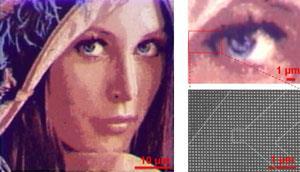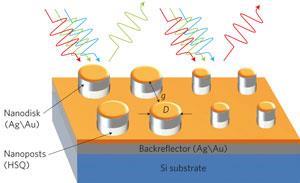
Just as stained glass uses suspensions of gold and silver nanoparticles to achieve different colours, by varying the size and spacing between the nanoposts Wang was able to create a full palette. And as proof, he printed a 50 x 50µm Lena image (pictured), which is often used as a printing standard.

The image is made by etching nanoposts, of defined sizes and spacing, out of silicon coated with a reflective gold-silver alloy. The posts are then topped with more of the gold-silver alloy to create the colour by particle resonance.
Because the colour is structural in origin the colour shouldn’t fade over time, unlike dyes, making the technique useful as a ‘watermark’ or for long term information storage.






No comments yet